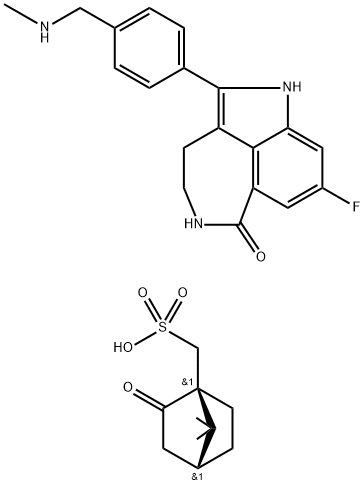1859053-21-6
 1859053-21-6 結構式
1859053-21-6 結構式
基本信息
瑞卡帕布樟腦磺酸鹽
英文同義詞: RUCAPARIB CAMSYLATE
PARP抑制劑(RUCAPARIB CAMSYLATE)
Rucaparib Camphosulfonate
8‐Fluoro‐2‐(4‐methylaminomethyl‐phenyl)‐1,3,4,5‐tetrahydro‐azepino[5,4,3‐cd] indol‐6‐one (S)‐camphorsulfonate Salt
Bicyclo[2.2.1]heptane-1-methanesulfonic acid, 7,7-dimethyl-2-oxo-, (1S,4R)-, compd. with 8-fluoro-1,3,4,5-tetrahydro-2-[4-[(methylamino)methyl]phenyl]-6H-pyrrolo[4,3,2-ef][2]benzazepin-6-one (1:1)
物理化學性質(zhì)
常見問題列表
|
PARP-1 1.4 nM (Ki) |
Rucaparib is the most potent PARP inhibitor in enzyme assays (K i , 1.4 nM), and a possible N-demethylation metabolite of AG14644. The radio-sensitization by Rucaparib is due to downstream inhibition of activation of NF-κB, and is independent of SSB repair inhibition. Rucaparib could target NF-κB activated by DNA damage and overcome toxicity observed with classical NF-κB inhibitors without compromising other vital inflammatory functions. Rucaparib inhibits PARP-1 activity by 97.1% at a concentration of 1 μM in permeabilised D283Med cells.
Rucaparib and AG14584 significantly (P < 0.05) increases temozolomide toxicity. Rucaparib (1 mg/kg) significantly increases temozolomide-induced body weight loss. Rucaparib (0.1 mg/kg) results in a 50% increase in the temozolomide-induced tumor growth delay. Rucaparib is not toxic but significantly enhances temozolomide-induced TGD in the DNA repair protein-competent D384Med xenografts. Pharmacokinetics studies also show that Rucaparib is detected in the brain tissue, which indicates that Rucaparib has potential in intra-cranial malignancy therapy. Rucaparib significantly potentiates the cytotoxicity of topotecan and temozolomide in NB-1691, SH-SY-5Y, and SKNBE (2c) cells. Rucaparib enhances the antitumor activity of temozolomide and indicates complete and sustained tumor regression in NB1691 and SHSY5Y xenografts.
